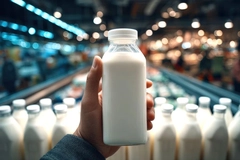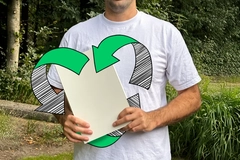Wrapping up bottled water

The PET bottles at Earth20 are received on pallets. After depalletizing, they are conveyed into an enclosed room for increased sanitation where rinsing, filling, capping and labeling take place. To start the operation, bottles enter an air rinser from Bevco Conveying Systems . At the entrance to the rinser, the bottles are picked up by parallel-gripper conveyors running at a higher speed than the infeed conveyor to pull a gap between the bottles.
The PET bottles at Earth20 are received on pallets. After depalletizing, they are conveyed into an enclosed room for increased sanitation where rinsing, filling, capping and labeling take place. To start the operation, bottles enter an air rinser from Bevco Conveying Systems . At the entrance to the rinser, the bottles are picked up by parallel-gripper conveyors running at a higher speed than the infeed conveyor to pull a gap between the bottles. The bottles are inverted around wheels and moved over air jets, followed by a vacuum header. The bottles are then turned right-side-up around another set of wheels, and are deposited on the outfeed conveyor. The speed of this conveyor closely matches the speed of the grippers to ensure the maintenance of a gap between bottles. This gap is read to determine a backup on the line, and if a backup occurs, the rinser, including the infeed conveyor, will stop before the backup reaches the machine. The machine will automatically restart when the backup clears. A sensor at the infeed of the rinser reads the presence of bottles, and if there are no bottles for a preset length of time, the air will shut off. As soon as bottles are detected again, it will restart before the bottles hit the air header. A switch at the outlet of the rinser instantly stops the machine if a bottle jam occurs. As this is usually caused by an unusual backup condition, the outfeed of the machine must be cleared and the rinser manually restarted. A pressure switch shuts down the machine if the rinse medium hits a low-pressure condition. With this switch, the rinser will not run if the operator fails to open the infeed valve on the unit on startup. It will also shut down if air pressure is lost in the middle of a run. The gripper spacing is changed by using a handwheel to adjust for different bottle sizes. The spray header is also adjusted with a handwheel to set the nozzle height in relation to the bottle neck. Bottles are then conveyed to a monobloc gravity filler/capper from Fogg Filler Co. that has 48 filling stations and 16 capping heads. During operation, a timing screw at the inlet of the filler meters the bottles into a starwheel that, in turn, places them onto individual spring-loaded bottle pedestals. As the machine rotates, each pedestal raises the bottle up against a seal on the bottom of the gravity-fill valve, which incorporates a vent. A guide on the bottom of the valve ensures that the top of the bottle is centered against the valve. As the pedestal continues to lift the bottle, it pushes up the valve sleeve, and filling commences. This continues as the filler rotates until the product reaches the bottom of the valve sleeve. As the bottle fills, air is displaced into the top of the filler bowl through the vent. The filling cycle is set so that the product reaches the bottom of the valve sleeve as the filler rotation brings the bottle near the machine-discharge starwheel. At this point, the bottle pedestal descends, allowing the fill valve to close, and the bottles travel into the discharge starwheel.











